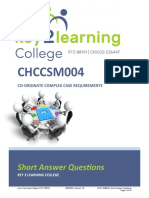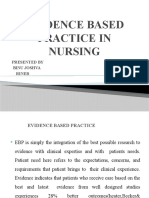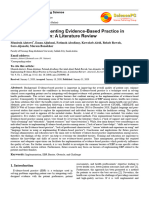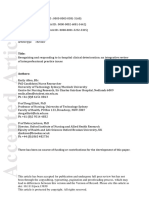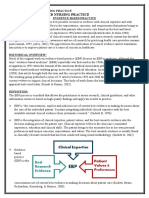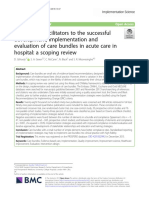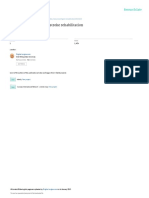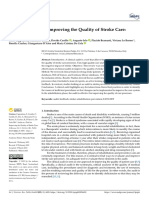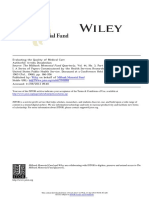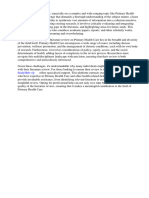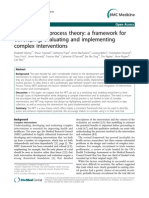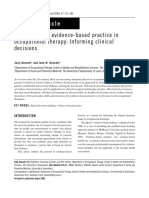Editorial: Evidence-Based Decision Making in Occupational Health
Editorial: Evidence-Based Decision Making in Occupational Health
Uploaded by
NutanCopyright:
Available Formats
Editorial: Evidence-Based Decision Making in Occupational Health
Editorial: Evidence-Based Decision Making in Occupational Health
Uploaded by
NutanOriginal Title
Copyright
Available Formats
Share this document
Did you find this document useful?
Is this content inappropriate?
Copyright:
Available Formats
Editorial: Evidence-Based Decision Making in Occupational Health
Editorial: Evidence-Based Decision Making in Occupational Health
Uploaded by
NutanCopyright:
Available Formats
Occupational Medicine 2005;55:1–2
doi:10.1093/occmed/kqh118
EDITORIAL
Evidence-based decision making in approach requiring the conscientious (to apply the best
occupational health evidence when possible), judicious (to use recommen-
dation for patients/workers/community), explicit (to
Evidence-based medicine (EBM) is founded on the transparently demonstrate the reliability of each decision)
appealing paradigm of promoting the identification, integration of relevant scientific evidence relating to the
appraisal and application of the best practices in health stakeholders’ needs. This definition does not replace
care, supporting doctors in the decision making process. clinical skills or other abilities, and the experience of
The continuous development of health care presents a professionals, but provides a picture of the relationships
Downloaded from https://academic.oup.com/occmed/article-abstract/55/1/1/1392156 by guest on 22 September 2019
solid ground for more effective practices; however, among different components of the decision process [8].
research findings in the health services suggest that The health problem is a key factor in the decision
there is a gap between evidence and practice [1]. EBM process. Differing from the EBM model, in the evidence-
has raised awareness among practitioners and decision based occupational health model the problem can involve
makers, but the approach is not followed in everyday a community of workers or an individual. Circumstances
practice for several reasons. These include the complex are another key factor: the problem may be approached
literature organization, its irrelevance to clinical practice, differently in different settings, depending on the different
the difficulty in applying its results to the individual context and time in which it occurs. Unlike the EBM
patient and the barrier to change. As a consequence, model, patients’ preferences should be viewed as the
ineffective practices are performed for several reasons, preferences of the different stakeholders (the employer,
including over-reliance on a surrogate outcome, the love the company management, the representative of the
of a wrong pathophysiological model and the need to do workers, the inspection labour, the trade union and the
something [2]. workers preferences), since interventions cannot be
So far, health service research in occupational health carried out unless the stakeholders’ needs and interests
has not provided relevant information about the appro- are met. In comparison with clinical research, the
priateness of usual practices. However, there is a growing research for evidence in occupational health is different
awareness and pressure that a decision in occupational both in the evidence searching stage (RCT studies are
health practice should be supported by the best available often unavailable) and in the evidence appraisal stage
evidence in order to maximize the outcome. In the past (evidence alone is not always an adequate guide to action
few years, Occupational Medicine has hosted papers and and applicability, and economic evaluation and barriers
editorials dealing with this intriguing topic [3 – 5] to implementation should be considered).
supporting the need to transfer scientific evidence into The stakeholders’ needs can be translated into action
daily practice. However, as for general practitioners, within this framework. This requires starting the tra-
several obstacles exist when approaching problems ditional five-step EBM process [7], to which an
according to the EBM principles: lacking skill in additional step was recently added [9]: (i) transforming
formulating answerable questions, insufficient time the problem into a question; (ii) answering the question
required to find information and scarce capacity of based on the internal evidence (the evidence derived from
integrating evidence to make decisions. knowledge acquired through education and training, and
Like health care professionals, occupational health experience built from daily practice); (iii) finding the
professionals must rely on the best available evidence external evidence (information from scientific literature)
supporting the appropriateness of diagnostic tests and to answer the question; (iv) critically appraising the
preventive or clinical interventions. Therefore, like in external evidence for its validity and usefulness; (v)
health care, scientific literature is a crucial element of the integrating internal and external evidence to answer the
evidence-based decision making process. The appropri- question; and (vi) evaluating the decision.
ateness of the practice is one of the key elements of any The first step consists of converting information
intervention, as was stated 20 years ago by the Inter- needs/problems into questions to be answered. The
national Labour Office [6], who suggested that quality- evidence-based approach guides professionals in struc-
oriented services founded on sound evidence-based turing well-built questions that result in patient/commu-
practice should be supplied. nity-centred answers. Asking the right question is
The principles of EBM can be adapted in occupational difficult, yet fundamental to evidence-based practice or
health practice, whose evidence-based decision process skill. The process begins with a patient question or
can be defined as the current best evidence in making problem. A well-built question usually includes four
decisions [7]. The decision process consists of an components, referred to as the PICO. The acronym
Occupational Medicine, Vol. 55 No. 1
q Society of Occupational Medicine 2005; all rights reserved 1
2 OCCUPATIONAL MEDICINE
PICO identifies the patient/population (P), the interven- both comments and criticisms on this topic, and
tion (I), the condition/comparison/control (C) and submission of problems for which this approach was
the outcome (O). P indicates a worker or a workers’ used. Should the topic raise the interest of occupational
group, I includes the intervention or the practice adopted health professionals, a new peer-reviewed series, ‘evi-
(e.g. medical examination or screening tests, information dence-based occupational health in practice’, could be
to workers), C identifies the condition (e.g. exposure to launched. This series would aim at guiding the decision
chemicals, ergonomic factors or unexpected excess of making process according to the EBM principles largely
health changes) and O represents the outcome (e.g. blood adopted in different medical specialities, thereby helping
lead reduction or reduction of accidents in the population readers to develop skills of using research evidence in their
following the intervention). The four components should practice and making knowledge transfer from research
be integrated in an answerable question, e.g. ‘in a group into practice more effective.
Downloaded from https://academic.oup.com/occmed/article-abstract/55/1/1/1392156 by guest on 22 September 2019
of operating room workers (P) exposed to anaesthetics
(C), does a training course (I) reduce the levels of urinary Giuliano Franco
anaesthetics at the end of the shiftwork (O)?’ After the Department of Internal Medicine,
second step (answering the question based on the School of Medicine, Largo del Pozzo 71,
evidence acquired from personal knowledge and experi- I-41100 Modena, Italy
ence), the third step involves a well-conducted literature
search for finding the best external evidence. Finding
relevant evidence requires conducting a focused search
(based on the keywords provided by the question) of the References
peer-reviewed professional literature based on the appro-
priate methodology. The availability of online databases 1. Grol R, Grimshaw J. From best evidence to best practice:
effective implementation of change in patients’ care. Lancet
(such as Medline and the Cochrane Library) has made
2003;362:1225– 1230.
locating relevant evidence easier and faster. The fourth
2. Doust J, Del Mar C. Why doctors use treatments that do
step consists of the critical appraisal of the evidence for its not work? Editorial. Br Med J 2004;328:474– 475.
applicability to the problem, which entails understanding 3. Carter T. The application of the methods of evidence-based
the value of the collected findings and their relevance to practice to occupational health. Occup Med (Lond) 2000;
the problem. The strengths and weaknesses of the 50:231 – 236.
findings should be determined, and the usefulness and 4. D’Auria D. Evidence-based occupational medicine: the
applicability of the evidence to the specific patient/ good, the bad and the otherwise difficult. Editorial. Occup
population problem should be assessed. The last two Med (Lond) 2000;50:211.
steps involve applying the results of the appraisal, 5. Franco G. The future of occupational health practice:
integrated with the internal evidence and evaluating the reconciling customer expectation and evidence based
practice. Editorial. Occup Med (Lond) 2001;51:482– 484.
process and the professional performance. The two
6. International Labour Office. ILO Convention No. 161 on
sources of the information (internal and external) may
Occupational Health Services, 161. Geneva: ILO, 1985.
be compatible or conflicting, leading to a decision 7. Sackett DL, Richardson WS, Rosenberg WMC, Haynes
depending on multiple factors (including circumstances, RB. Evidence Based medicine. How to Practice and Teach
settings and the stakeholders’ preferences). Finally, the EBM. New York: Churchill Livingstone, 1997.
analysis of the whole process is examined and opportu- 8. Franco G. Evidence-based medicine and evidence-based
nities for change can be recognized. occupational health. Scand J Work Environ Health 2003;29:
The case studies appearing in this issue [10,11] are an 78 – 79.
example of how the problem is transformed to an 9. Porzsolt F, Ohletz A, Thim A, et al. Evidence-based
answerable question, how the information is searched decision making. The 6-step approach. ACP J Club 2003;
and appraised, and how the decision is taken. The focus is 139:A11 –A12.
10. Monduzzi G, Franco G. Practising evidence-based occu-
more on the process than on the outcome (some experts
pational health in individual workers: how to deal with a
could disagree with the final decision), and the reports
latex allergy problem in a health care setting. Occup Med
aim at providing an approach to an occupational health (Lond) 2005;55:3 –6.
problem. This model highlights the need for updated 11. Grandi P, Franco G. Practising evidence based occu-
information, whose application results in an appropriate pational health in workers’ groups: how to prevent sickness
decision and addresses some obstacles met across the absence caused by influenza. Occup Med (Lond) 2005;55:
decision making process. Occupational Medicine welcomes 7 –9.
You might also like
- Short Answer Questions CHCCSM004Document14 pagesShort Answer Questions CHCCSM004Tmg Preity100% (2)
- Java Project ReportDocument28 pagesJava Project ReportPraveen Rana50% (2)
- Sample Roofing DetailsDocument1 pageSample Roofing DetailsSasheen Dela Cruz67% (3)
- Evidence Based PracticeDocument10 pagesEvidence Based PracticeDiwakar RedhuNo ratings yet
- Topic-Evidence Based Nursing Practice And: Best PracticesDocument15 pagesTopic-Evidence Based Nursing Practice And: Best PracticesgemergencycareNo ratings yet
- The Barrier To Implementation of Evidence-Based Practice Among Novice TherapistsDocument11 pagesThe Barrier To Implementation of Evidence-Based Practice Among Novice TherapistsInternational Journal of Innovative Science and Research TechnologyNo ratings yet
- Evidence Based Practice in Nursing BinuDocument51 pagesEvidence Based Practice in Nursing BinuBinu Joshva100% (3)
- Chapter 81Document11 pagesChapter 81Sri HariNo ratings yet
- Bab 2Document26 pagesBab 2Ayu SriNo ratings yet
- All India Institute of Medical Sciences, Jodhpur College of NursingDocument15 pagesAll India Institute of Medical Sciences, Jodhpur College of NursingGaje SinghNo ratings yet
- Developing A Viva Exam To Assess ClinicalDocument9 pagesDeveloping A Viva Exam To Assess ClinicalROGERNo ratings yet
- The ACE Star Model of Knowledge TransformationDocument4 pagesThe ACE Star Model of Knowledge TransformationDesi Puspita IndahNo ratings yet
- BMC Health Services Research: A Rational Model For Assessing and Evaluating Complex Interventions in Health CareDocument11 pagesBMC Health Services Research: A Rational Model For Assessing and Evaluating Complex Interventions in Health CareafreenahmadNo ratings yet
- Evidence Based Practice ProcessDocument29 pagesEvidence Based Practice ProcessDrmirfat AlkashifNo ratings yet
- Ajns 20200901 16Document8 pagesAjns 20200901 16Trường Giang NguyễnNo ratings yet
- Knowledge Translation of Research Findings: Debate Open AccessDocument17 pagesKnowledge Translation of Research Findings: Debate Open AccessHANo ratings yet
- 3 - 4 Research Steps With The Best EvidenceDocument16 pages3 - 4 Research Steps With The Best EvidenceNaufal FadlanNo ratings yet
- Recognising and Responding To In-Hospital Clinical DeteriorationDocument39 pagesRecognising and Responding To In-Hospital Clinical DeteriorationPAULA SORAIA CHENNo ratings yet
- Evidence Based Practice in NursingDocument86 pagesEvidence Based Practice in NursingKrea kristalleteNo ratings yet
- Evidence Based Practice in NursingDocument86 pagesEvidence Based Practice in NursingKrea kristalleteNo ratings yet
- Evidenced Based Nursing PracticeDocument7 pagesEvidenced Based Nursing PracticeKim ViñasNo ratings yet
- 022 Use of Motivational Interviewing by Non-Clinicians in Non-Clinical Settings 2012Document15 pages022 Use of Motivational Interviewing by Non-Clinicians in Non-Clinical Settings 2012ISCRRNo ratings yet
- Week 1 1Document8 pagesWeek 1 1R-jeyn TorresNo ratings yet
- Subject: Advanced Nursing Practice Evidence Based PracticeDocument7 pagesSubject: Advanced Nursing Practice Evidence Based PracticerinkuNo ratings yet
- 2019 Article 894Document12 pages2019 Article 894Elfina NataliaNo ratings yet
- Evidence Stroke PDFDocument4 pagesEvidence Stroke PDFRizky MakuNo ratings yet
- Conceptual Models in Health Informatics Research: A Literature Review and Suggestions For DevelopmentDocument9 pagesConceptual Models in Health Informatics Research: A Literature Review and Suggestions For DevelopmentDr Gul WasimNo ratings yet
- User Manual Clinical ReasoningDocument7 pagesUser Manual Clinical ReasoningMajid JafarzadehNo ratings yet
- Physical Therapy Tests in Stroke RehabilitationDocument22 pagesPhysical Therapy Tests in Stroke Rehabilitationmehdi.chlif4374No ratings yet
- Evidence-Based Dentistry What's NewDocument5 pagesEvidence-Based Dentistry What's NewGanisht AzmiNo ratings yet
- 556-Appropriateness of Clinical Decision Support - Final White Paper-Wei WuDocument15 pages556-Appropriateness of Clinical Decision Support - Final White Paper-Wei Wuapi-398506399No ratings yet
- Evidence - Based Practice in PhysiotherapyDocument17 pagesEvidence - Based Practice in Physiotherapyparneetkaurbedi100% (2)
- Evidence Based Practice in NursingDocument9 pagesEvidence Based Practice in NursingSimran Chauhan100% (2)
- Audit As A Tool For Improving The Quality of Stroke CareDocument11 pagesAudit As A Tool For Improving The Quality of Stroke Carejasonongsp1992No ratings yet
- Campbell BMJ2000Document3 pagesCampbell BMJ2000Sureshkumar KamalakannanNo ratings yet
- Ebp (Evidence-Based Practice)Document11 pagesEbp (Evidence-Based Practice)TrishaNo ratings yet
- Study Guide For Nursing Informatics1Document11 pagesStudy Guide For Nursing Informatics1Jann ericka Jao100% (1)
- Running Head: Evidence-Based Nursing Journal 2 1Document9 pagesRunning Head: Evidence-Based Nursing Journal 2 1rnrmmanphdNo ratings yet
- KN ClinicalGuidelines2Document2 pagesKN ClinicalGuidelines2Mhmd IrakyNo ratings yet
- PJBL 2Document7 pagesPJBL 2Andi NirmalasariNo ratings yet
- Ramalho 2019 - Plosone - q2Document20 pagesRamalho 2019 - Plosone - q2nanaloboNo ratings yet
- NUPC 103: Dario M. Ragmac, RNDocument26 pagesNUPC 103: Dario M. Ragmac, RNArmie Erika JovellanosNo ratings yet
- Wiley Milbank Memorial FundDocument42 pagesWiley Milbank Memorial FundLuciana NovaesNo ratings yet
- Primary Health Care Literature ReviewDocument4 pagesPrimary Health Care Literature Reviewafdtbluwq100% (1)
- EVIDENCE BASED PRACTICE Tools and TechniDocument16 pagesEVIDENCE BASED PRACTICE Tools and Technihassan mahmoodNo ratings yet
- Framing A Research Question and Generating A Research HypothesisDocument6 pagesFraming A Research Question and Generating A Research HypothesisOluwajuwon AdenugbaNo ratings yet
- Normalisation Process Theory A Framework For Developing, Evaluating and Implementing Complex InterventionsDocument12 pagesNormalisation Process Theory A Framework For Developing, Evaluating and Implementing Complex InterventionsTran Ngoc TienNo ratings yet
- Developing A Theory-Based Instrument To Assess The Impact of Continuing Professional Development Activities On Clinical Practice: A Study ProtocolDocument6 pagesDeveloping A Theory-Based Instrument To Assess The Impact of Continuing Professional Development Activities On Clinical Practice: A Study ProtocolSjktraub PahangNo ratings yet
- Practice Guidelines: Go ToDocument2 pagesPractice Guidelines: Go TokapilscribNo ratings yet
- Aspects Affecting Occupational Therapists Reasoning When Implementing Research Based Evidence in Stroke RehabilitationDocument15 pagesAspects Affecting Occupational Therapists Reasoning When Implementing Research Based Evidence in Stroke RehabilitationMuskaan KhannaNo ratings yet
- Implications in Practice and Conclusions - EditedDocument11 pagesImplications in Practice and Conclusions - EditedAtanas WamukoyaNo ratings yet
- Evidence Based Dentistry: An Overview: Dr. R MadhumalaDocument3 pagesEvidence Based Dentistry: An Overview: Dr. R MadhumalaSitta Dea ViastiyaNo ratings yet
- 18 Surgical Innovation in IndiaDocument7 pages18 Surgical Innovation in IndiaAvinash SupeNo ratings yet
- Unit 2 Evidence Based Nursing PracticeDocument94 pagesUnit 2 Evidence Based Nursing Practicenoo.wann100% (2)
- MacFarlane 2010 NormalizationDocument11 pagesMacFarlane 2010 NormalizationKarina CancellaNo ratings yet
- Frameworks For Embedding A Research Culture in Allied Health Practice: A Rapid ReviewDocument15 pagesFrameworks For Embedding A Research Culture in Allied Health Practice: A Rapid ReviewLUISA FERNANDA OCHOA VILLEGASNo ratings yet
- What Is EBD?Document7 pagesWhat Is EBD?RATHEESH M. S.No ratings yet
- Evidence-Based Dentistry. How To Design A Research? A Literature ReviewDocument7 pagesEvidence-Based Dentistry. How To Design A Research? A Literature ReviewNadya ANo ratings yet
- 2010 Evidence-Based Radiology Why and HowDocument16 pages2010 Evidence-Based Radiology Why and HowPeter Thaddeus RblsNo ratings yet
- Research Methodology in Dentistry: Part I - The Essentials and Relevance of ResearchDocument8 pagesResearch Methodology in Dentistry: Part I - The Essentials and Relevance of ResearchRomNo ratings yet
- Aus Occup Therapy J - 2001 - Bennett - The Process of Evidenceâ - Based Practice in Occupational Therapy Informing ClinicalDocument10 pagesAus Occup Therapy J - 2001 - Bennett - The Process of Evidenceâ - Based Practice in Occupational Therapy Informing ClinicalFelipe Gonzalez AlvarezNo ratings yet
- Starting Out With C++ by Tony Gaddis, (8 Edition PDF Book Shared On Group) Chapter 13 Introduction To ClassesDocument2 pagesStarting Out With C++ by Tony Gaddis, (8 Edition PDF Book Shared On Group) Chapter 13 Introduction To ClassesSadiq AhmadNo ratings yet
- 06 IntroductionDocument9 pages06 IntroductionSunny TuvarNo ratings yet
- Chapter 5 - Global IssuesDocument41 pagesChapter 5 - Global IssuesAansi Fuullee50% (2)
- Azure Devops SyllabusDocument7 pagesAzure Devops SyllabusAnil N100% (1)
- Syllabus Cyber Security and Web TechnologiesDocument2 pagesSyllabus Cyber Security and Web TechnologiesDr MadhurimaNo ratings yet
- TaniyaDocument10 pagesTaniyamittal_parmar5224No ratings yet
- Tugas Pidato Bhs InggrisDocument3 pagesTugas Pidato Bhs InggrisDudi SarifudinNo ratings yet
- Saudi Arabia Labor Market Report G20Document52 pagesSaudi Arabia Labor Market Report G20JobJob100% (1)
- 3.3 Actividad Apropiación de ConceptosDocument2 pages3.3 Actividad Apropiación de ConceptosyosmanNo ratings yet
- Four Types of CreutzfeldtDocument1 pageFour Types of Creutzfeldtkarenkaren09No ratings yet
- GasTurbines - CH 2 - Gas Turbine Thermodynamic CyclesDocument6 pagesGasTurbines - CH 2 - Gas Turbine Thermodynamic Cyclesنهاد نهاد100% (1)
- Keenan V Eshleman (Pagcaliwagan)Document2 pagesKeenan V Eshleman (Pagcaliwagan)AlexandraSoledadNo ratings yet
- Part A Reading Task Vitamin CDocument8 pagesPart A Reading Task Vitamin CMitra Nabizadeh100% (2)
- F4MYS Section B 2015 Jun (QS)Document3 pagesF4MYS Section B 2015 Jun (QS)rayyan darwishNo ratings yet
- Food Microbiology - FinalDocument4 pagesFood Microbiology - FinalBiệnCôngTrungNo ratings yet
- Ore MineralsDocument2 pagesOre MineralsErnesto Dasalla IIINo ratings yet
- Child Abuse FinalDocument14 pagesChild Abuse FinalloireenNo ratings yet
- MIS - Past Years Papers With SolutionDocument60 pagesMIS - Past Years Papers With SolutionArvindYadavNo ratings yet
- 06 03 AnalyzingDiatonicModes PDFDocument1 page06 03 AnalyzingDiatonicModes PDFDilson Colman CassaroNo ratings yet
- Application Form - New-Tup PDFDocument2 pagesApplication Form - New-Tup PDFDesiree Dela Cruz0% (1)
- Plots For Road To Vecna PlayersDocument34 pagesPlots For Road To Vecna PlayersAnonymous CoyoteNo ratings yet
- Data ProyekDocument2 pagesData ProyekNur AndiniNo ratings yet
- Akmu - Last Goodbye RomanizationDocument2 pagesAkmu - Last Goodbye RomanizationRea_stypayhorliksonNo ratings yet
- MG301 - Project SAMPLEDocument41 pagesMG301 - Project SAMPLEs11152130No ratings yet
- DLL 5SDocument5 pagesDLL 5SAngelo VillanuevaNo ratings yet
- Đề 19Document5 pagesĐề 19John SnowdenNo ratings yet
- Sodium Stearyl FumarateDocument2 pagesSodium Stearyl FumarateAldo Ilyan Perez MendezNo ratings yet
- Caja Santa Fe ManualDocument15 pagesCaja Santa Fe ManualAbraham VegaNo ratings yet
